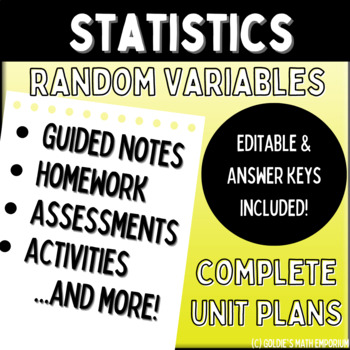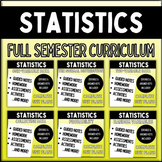Statistics: Random Variables
- Zip
Also included in
- Statistics: Full Curriculum This is the FULL CURRICULUM bundle for my regular-level, Statistics course. If you are looking for my full curriculum for AP Statistics, follow the link here. This full curriculum is six units long and lasts 1 semester, approximately 90 school days. The following units arPrice $99.00Original Price $120.00Save $21.00
Description
Statistics
Unit 6: Random Variables
This complete unit bundle teaches about discrete and continuous random variables, and the binomial, geometric, and Poisson probability distributions.
Welcome! This is the complete unit plan for the sixth unit in my regular level Statistics class.
The following in included in this resource:
- 5 complete sets of student guided notes (answer keys included)
- 6 homework problem sets + complete test review (answer keys included)
- 2 assessments – quiz and test (answer keys included)
- 2 in class review PowerPoint presentations
- 2 activities
- Suggested pacing and learning targets
All of the resources are 100% editable, to modify to fit your classroom needs. The zip folder includes the Word document, which you have permission to edit completely. The PDF version and answer keys are included for your convenience. There are also PowerPoint presentations for some of the review documents.
I teach this course without a textbook, so everything that is provided here, can be used without supplementation.
******************************************************************************
The student friendly learning targets for this unit are:
- Students will be able to represent and interpret the probability distribution for a discrete random variable.
- Students will be able to calculate and interpret the mean and standard deviation for a discrete random variable.
- Students will be able to understand the difference between a discrete and continuous random variable and be able to calculate probabilities associated with the normal distribution.
- Students will be able to calculate and interpret probabilities, and calculate and interpret the mean and standard deviation, for a binomial distribution.
- Students will be able to calculate and interpret probabilities, and calculate and interpret the mean and standard deviation, for a geometric distribution.
- Students will be able to calculate and interpret probabilities, and calculate and interpret the mean and standard deviation, for a Poisson distribution.
The Common Core Math Standards covered in this unit are:
- MD.A.1: (+) Define a random variable for a quantity of interest by assigning a numerical value to each event in a sample space; graph the corresponding probability distribution using the same graphical displays as for data distributions.
- MD.A.2: (+) Calculate the expected value of a random variable; interpret it as the mean of the probability distribution.
- MD.A.3: (+) Develop a probability distribution for a random variable defined for a sample space in which theoretical probabilities can be calculated; find the expected value.
- MD.A.4: (+) Develop a probability distribution for a random variable defined for a sample space in which probabilities are assigned empirically; find the expected value.
- MD.B.5: (+) Weigh the possible outcomes of a decision by assigning probabilities to payoff values and finding expected values.
- MD.B.5.A: Find the expected payoff for a game of chance.
- MD.B.5.B: Evaluate and compare strategies on the basis of expected values.
- MD.B.6: (+) Use probabilities to make fair decisions (e.g., drawing by lots, using a random number generator).
- MD.B.7: (+) Analyze decisions and strategies using probability concepts (e.g., product testing, medical testing, pulling a hockey goalie at the end of a game).
******************************************************************************
My regular level Statistics course includes the following units:
Unit 2 – The Normal Distribution
Statistics: Full Semester Curriculum Bundle (Units 1 – 6)
Unit 7 – Sampling Distributions
Unit 8 – Confidence Intervals (Coming Soon!)
Unit 9 – Hypothesis Testing (Coming Soon!)
Unit 10 – Comparing Two Populations (Coming Soon!)
Unit 11 – Chi-Square Distributions (Coming Soon!)
******************************************************************************
Q: How is this different from my AP Statistics Unit 4 Unit Plans?
A: My AP Stat Unit 4 plans follow the AP Stat CED, which covers probability and random variables in 15 days. This unit covers only random variables in 10 days, and there is a separate unit for probability. The notes are shorter (about 20-30 min a piece) and the homework will take less time than in the AP Statistics course. I also cover the Poisson Distribution in this course, which is not an AP Statistics topic.
Q: Can I use your AP Statistics materials in my on-level (regular level) Statistics course?
A: Absolutely! These unit plans fit a semester-long course in Statistics. My AP Statistics unit plans would fit perfectly for a year-long Statistics course, with a modified pacing schedule. You can check out the full curriculum here. If you have more questions about the differences and want some help deciding what would work best in your class, please feel free to reach out via email or Q&A on TPT.
******************************************************************************
If you need extra explanations or additional guidance, I would love to help!! Contact me at goldiesmathemporium[at]gmail.com for any questions or samples.
I want to provide the best possible resources to help other teachers out! You will be notified of any future updates and additions to this product and it will be free of charge. Your support is important and I thank you for allowing me to continue doing what I love to do.
Note: I am not affiliated with nor endorsed by any textbook or other curriculum provider. I am a classroom teacher who creates curriculum materials to help other teachers.
© Goldie’s Math Emporium, LLC
This work is bound by copyright laws and editing (beyond your own classroom use), selling, redistributing, or posting all or part of these documents on the Internet is strictly prohibited. Violations are subject to the Digital Millennium Copyright Act.



